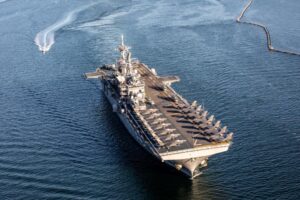The commander of U.S. 7th Fleet last week said recent experimentation with the America-class USS Tripoli (LHA-7) amphibious assault ship loaded with
Lockheed Martin [LMT] F-35B fighters tested how the vessel, dubbed an “assault carrier,” can work with a Navy aircraft carrier strike group.
Several months this year, the Navy experimented with the LHA-7 loaded with up to 20 F-35B Lightning II Joint Strike Fighters in a concept formerly called the “lightning carrier.” This was first fully demonstrated starting in late March (Defense Daily, April 15).
Speaking during an event hosted by the U.S. Naval Institute and Center for Strategic and International Studies, Vice Adm. Karl Thomas referred to the concept as an “assault carrier,” used by former Tripoli commanding officer and current commander of Naval Surface Group Western Pacific Yokosuka, Capt. Joel Lang.

Thomas said they are using assault carrier rather than lightning carrier because “one day you can have F-35Bs on the flight deck, the next day, you could have MV-22s and you can be putting Marines ashore. And so it’s just a very versatile instrument and the fact that you have 14 5th-gen fighters on board – it’s an incredibly capable sensor.”
He said the Navy is still in the experimentation phase and underscored “we wanted to really try to find out how would you integrate an assault carrier with a full-sized carrier. What missions might it be able to do?”
LHA-7 with F-35Bs participated in the ninth U.S.- only Valiant Shield field-training exercise in June, which also included the Nimitz-class aircraft carriers USS Abraham Lincoln (CVN-72) and USS Ronald Reagan (CVN-76).
“What we found is we distributed our three large decks for a period of time,” Thomas said.
Thomas said there are mission sets he believes the assault carrier will be designed for, in regions where it could operate in a better capacity.
“And then I think that because of the vertical takeoff nature of the F-35s, you can find yourself putting up F-35s in [Expeditionary Advanced Base Operations] and maybe you bring them back out to the ship for some maintenance and you move them elsewhere.”
Maybe you latch them up with the carrier and use the command and control or the electronic countermeasure capability of the [E-2D Advanced Hawkeye and EA-18G Growler aircraft]. So we’re still in an experiment phase.”
Thomas argued an LHA with 14 F-35Bs onboard “is much more capable than either of [China’s] current carriers, both from a sortie creation perspective, as well as just a sheer capability. There is no comparison between a J-15 and F-35 Bravo.”
He also pointed out the U.K. Royal Navy’s experimenting with a squadron of F-35Bs off the HMS Queen Elizabeth (R08) and Japan doing the same with its JS Izumo (DDG-183) helicopter destroyer further show the “capability you can bring with F-35Bs on the flattop.”